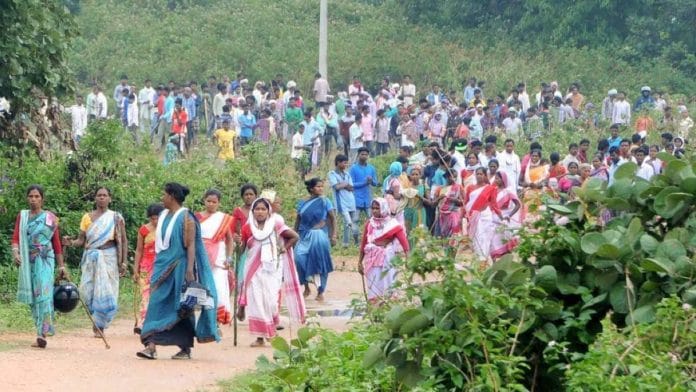New Delhi: On the birth anniversary of tribal icon Birsa Munda Wednesday, Prime Minister Narendra Modi will launch the Rs 24,000-crore pradhan mantri particularly vulnerable tribal groups (PM-PVTG) mission — officially called the Pradhan Mantri Janjatiya Adivasi Nyay Maha Abhiyan — that is aimed at providing essential services and improving the socio-economic condition of marginalised tribal groups in the country.
The Centre has planned interventions for holistic development of 75 PVTGs in 18 states and Union Territories under the mission, which will be launched in Jharkhand.
Announced by Union finance minister Nirmala Sitharaman during the budget this year, the mission comes ahead of assembly elections in five states, of which Telangana, Rajasthan, Madhya Pradesh and Chhattisgarh have PVTG population.
Madhya Pradesh and Chhattisgarh have a PVTG population of around 4.1 lakh and 1.1 lakh, respectively, according to the 2011 Census.
From drinking water supply to providing 4G network connectivity, the Centre plans to carry out development work through convergence of central schemes by nine ministries such as rural development, telecommunication, health, education, women and child development, etc, according to senior tribal affairs ministry officials.
ThePrint explains the contours of the “first-of-its-kind initiative” for vulnerable tribal groups, the proposed interventions, their implementation and possible impact.
Also Read:
What is PM-PVTG Mission all about?
The estimated population of 75 PVTGs is around 28 lakh. According to the tribal affairs ministry, these marginalised groups are living in 22,544 villages across 220 districts in 18 states and UTs.
Under the Rs 24,000-crore scheme, Rs 15,000 crore will be the Centre’s contribution and the rest will be contributed by states and UTs with PVTG population, a senior tribal affairs ministry official told ThePrint.
The mission will be implemented over a period of three years through convergence of ongoing central government schemes.
Although the tribal affairs ministry allocates Rs 250 crore annually under ‘Development of Particularly Vulnerable Tribal Groups’, it is for the first time that welfare measures are being proposed on such a large scale for these groups, the official said.
“The states are contributing in the implementation of various central schemes such as Pradhan Mantri Awas Yojana, PM Gram Sadak Yojana, etc. Under the mission, the plan is to ensure all essential services in these 22,000-plus villages and socio-economic development of these vulnerable groups,” said another tribal affairs ministry official.
The ministry has identified 11 interventions — provision of housing, healthcare facilities, water supply, road connectivity, 4G and mobile network, electrification of houses, education, anganwadi centres, multipurpose facility centres, livelihood options and focused development of 60 PVTG blocks (out of 500 Aspirational Blocks Programme) — in PVTG villages or habitations for the mission, according to officials.
“These tribes stay in scattered, remote and inaccessible habitations, often in forest areas, and hence a mission is planned to saturate PVTG families and habitations with basic facilities such as road and telecom connectivity, electricity, sustainable livelihood opportunities (among others),” the ministry said in a statement Tuesday.
Apart from this, special effort will be made to ensure saturation of initiatives such as Pradhan Mantri Jan Arogya Yojana, National Sickle Cell Disease Elimination Mission, TB elimination, 100 percent immunisation, PM Surakshit Matritva Abhiyan, PM Matru Vandana Yojana, PM-POSHAN, PM Jan Dhan Yojana, etc.
Nine ministries to come together
For implementation of the 11 interventions proposed under the mission, nine central government ministries will come together.
The tribal affairs ministry will be the nodal ministry for the project and will hold regular meetings with other ministries, states and UTs to monitor progress, clear administrative hurdles and ensure smooth implementation of the PM-PVTG Mission.
To ensure effective and timely implementation of various measures, it has prepared a set of guidelines after consulting other ministries that will be instrumental in the implementation of the proposed interventions.
Water supply, healthcare facilities, schools, road connectivity and housing are key requirements in most PVTG habitations, according to senior ministry officials.
“All the interventions will be carried out by various ministries through their ongoing welfare schemes,” the second tribal ministry official said, adding that amendments will be made in the ongoing schemes to ensure that all PVTG habitations are covered.
For housing, the tribal affairs and rural development ministries have carried out a gap analysis so that homes can be provided under the Pradhan Mantri Awas Yojana.
Gap analysis involves comparing the existing state of a business or, in this case, a government scheme, to a desired future state in order to help identify and close gaps.
As a large number of PVTGs live in forest areas and don’t own land parcels, efforts are being made to provide them houses under the Pradhan Mantri Awas Yojana, which is being implemented by the rural development ministry.
During an assessment earlier this year, it was found that 3,000 PVTG villages don’t have any mobile network or 4G network, said ministry officials, adding that efforts will be made to provide mobile connectivity in such villages.
According to the officials, social and other infrastructure in tribal areas is being mapped through the PM Gati Shakti National Master Plan, which was launched in 2021 to bring 16 ministries together for integrated planning and coordinated implementation of infrastructure connectivity projects.
(Edited by Nida Fatima Siddiqui)
Also Read: ‘Want to study’ — Jharkhand tribal woman who was ‘kicked, tortured, choked’ by BJP woman leader






